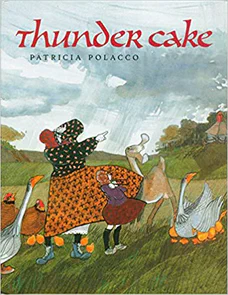Thunder Cake
Written and illustrated by Patricia Polacco
32 pages
•
Published 1990 (Philomel Books)

Recommended Age Range: Preschool through 2nd grade.
Publisher's Summary:
A loud clap of thunder booms, and rattles the windows of Grandma’s old farmhouse. “This is Thunder Cake baking weather,” calls Grandma, as she and her granddaughter hurry to gather the ingredients around the farm. A real Thunder Cake must reach the oven before the storm arrives. But the list of ingredients is long and not easy to find . . . and the storm is coming closer all the time! Reaching once again into her rich childhood experience, Patricia Polacco tells the memorable story of how her grandma–her Babushka–helped her overcome her fear of thunder when she was a little girl. Ms. Polacco’s vivid memories of her grandmother’s endearing answer to a child’s fear, accompanied by her bright folk-art illustrations, turn a frightening thunderstorm into an adventure and ultimately . . . a celebration!

Dr. Annie's Takeaways
Recommended for: A sweet book to read with a child who is afraid of loud thunderclaps. It teaches children to count the seconds between a lightning flash and a thunderbolt as the storm approaches, and it reminds children that they can be scared and still be brave. Do not read this book with a child if you aren’t open to baking a cake with a frightened child during the next thunderstorm. It’s just about non-optional.
Would a child like it? Many children will enjoy the countdown aspect of the book (the little girl is taught to count the seconds between the lighting flash and thunderclap, and it gets shorter and shorter over the course of the book). If this book comes with the promise of baking and eating a cake during the next storm, this book could become a favorite.
Evidence-Based Practices:
Exposure
Tone: Exciting, cozy
Story Quality: This is a sweet, classic story based on prolific children’s book author Patricia Pollaco’s childhood summers in Michigan with her Russian immigrant grandmother. It’s a countdown to a storm arriving, and it ultimately instills a sense of excitement in the reader, rather than dread, when a storm is coming. The writing is pretty and descriptive.
Illustrations: Warm, richly patterned illustrations.
Representation: The little girl in the story (based on the author as a child) is White, and she lives with her grandmother who is Russian (as stated in the author’s introduction to her YouTube reading of the story). Her grandmother lives on a farm in the Midwestern United States.
Psychological Practices: As the little girl helps her grandmother collect the necessary ingredients to make “thunder cake,” she repeatedly states that she is scared, but despite her fear she is able to do all of the necessary tasks (e.g., collect eggs from a hen she is worried will pack her). Her grandmother reassures her that she is there and the girl will be safe. Once the cake is in the oven, her grandmother points out how brave she was and corrects the girl when she protests that she was scared. It’s a great reminder that being scared but doing something anyway is the ultimate in bravery. If a family is inspired by this book and decides to make their own thunder cake during the next storm (this book very nearly requires this!), it could decrease a child’s aversion to thunderclaps by pairing the experience with something pleasurable and exciting.
Concerns: After the girl’s grandmother points out how brave she has been and the little girl agrees, there is a line that seems to go against the previous more helpful messaging about bravery. The grandmother tells the girl, “Brave people can’t be afraid of a sound” as a means of reassuring her that she can handle the thunderclaps. It’s not true, though. Of course brave people can be afraid of a sound. And it counteracts her previous reassurance that the girl can be brave even when she’s scared.
